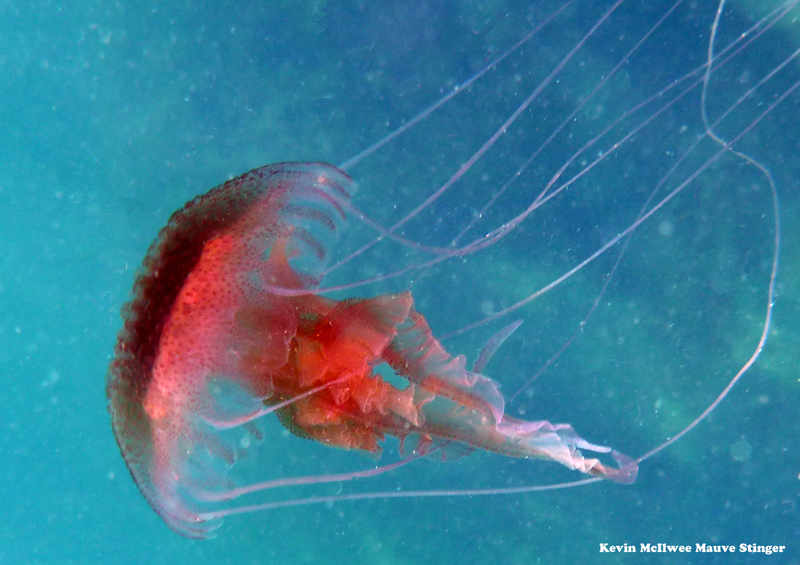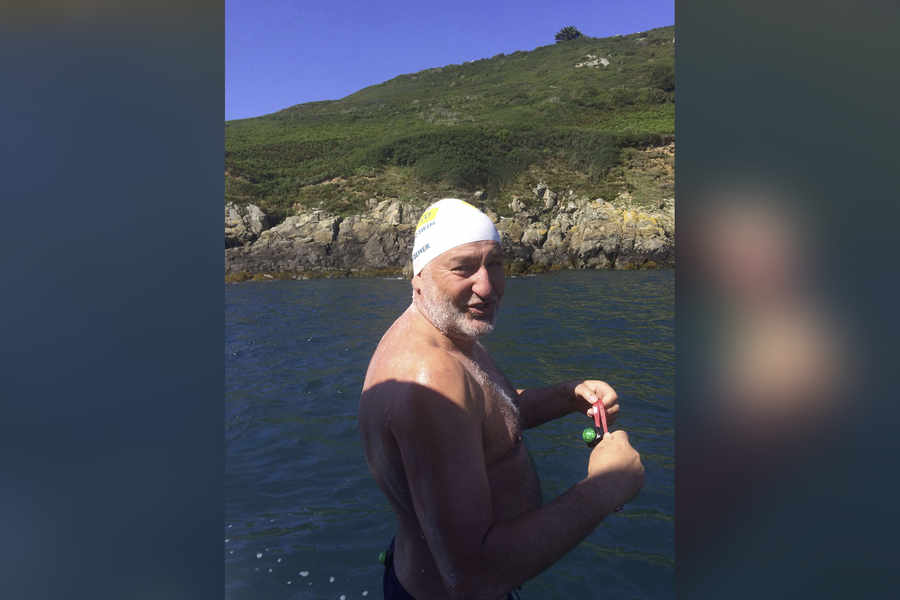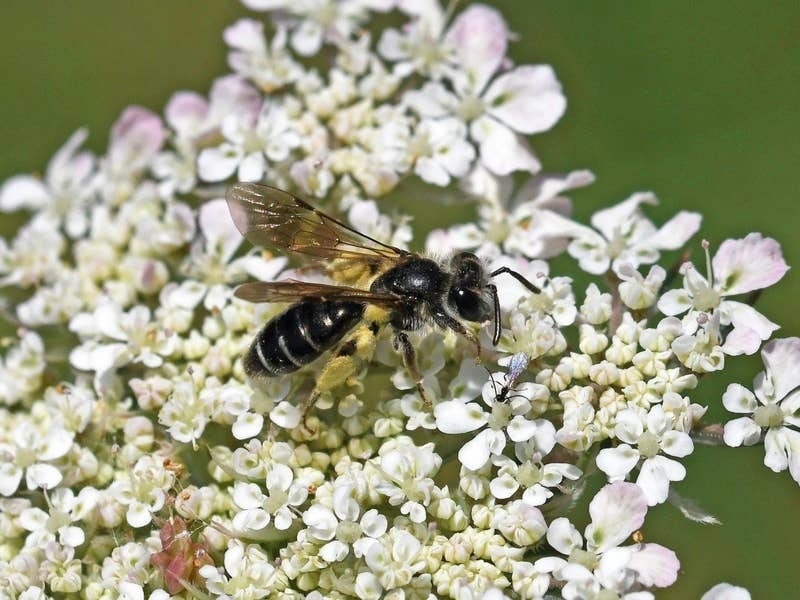Mr Faudemer (55), who is the first man to complete the swim, set out from St Martin’s Point in Guernsey at 11.45 am on Friday and came out of the water near Big Vern’s in St Ouen’s Bay after 14 hours and 57 minutes.
In doing so he broke the previous record set by Ruth Oldham, who completed the swim in 1962 in 15 hours and 15 minutes.

Guiding the support boat was skipper Matthew Clarke, with fellow long-distance swimmers Wendy Trehiou, Sarah Pierce and St Brelade Constable Steve Pallett, who during the swim got in the water with Mr Faudemer to keep him company.
‘For various reasons, Neil has not managed to do it before, but when he got in on Friday we all knew he was there to finish this time,’ said Mr Pallett. ‘He had that grit and determination.
‘The jellyfish were horrendous – I looked over the side of the boat and there was nowhere to swim without touching the jellyfish. But he bounced through that for a couple of hours, swam steadily all the way through. Then we were into the night, and it was dark and cold, and I joined him for an hour – it was not very pleasant, even for just an hour.
‘It really is quite an achievement and a really difficult swim, because of the tides.’

Mr Pallett said there was ‘quite a swell’ from the start and throughout the whole swim, although the sea was flattish. ‘It was difficult coming in to the beach. But Neil had done the training, that had gone well, and he was in good shape. It was an epic swim and fair play to him.’
Mr Faudemer was unavailable for comment.
Mr Faudemer’s four previous attempts – in 2012, 2013 and 2014 – were thwarted not only by the notoriously strong tides, but also hypothermia in 2013, which resulted in him being pulled unconscious from the water after five and a half hours.

EVERY summer, a swimmer, kayaker, surfer or other sea-going Islander or tourist is likely to have a close encounter with a jellyfish.
Usually, however, they are the type whose sting is hardly noticed.
And they are usually relatively few and far between. But this year things have been rather different.
During the last few weeks, several swimmers in Bouley Bay have been stung, with some being left with an extremely painful rash and a fear of returning to the sea this summer.
Initially it was thought the culprits were nettlefish (also known as sea nettles) – a stinging jellyfish more at home off the east coast of the USA than the waters of the English Channel.
And the concern was so great that the Health Department took the unusual step of warning people to take extra care in the water, and urged parents not to let their little ones try to touch any of the creatures washed up on the beach.
Now, however, it is believed the creatures were mauve stingers – a relatively uncommon jellyfish which, as anyone who has come into contact with them will confirm, lives up to its name.
It is believed this year’s unusual bloom – which has seen hundreds occupy the waters in Bouley Bay and other parts of the north coast – was a result of warmer sea temperatures early in the year.

This is thought to have produced a strong breeding season, which has resulted in hundreds of mainly juvenile mauve stingers massing in the seas around the Island. Kevin McIlwee, co-ordinator of Sea Search, a group which records marine life in waters around Jersey, said: ‘The mauve stingers breed in a slightly different way to other jellyfish.
‘The difference is that jellyfish usually breed and produce larvae which drops to the seabed. Once it is ready it goes out on its own and floats up the water. However, the mauve stinger doesn’t drop its larvae onto the sea bed – they remain high up in the water.’
So it begs the question, what has been different this year?
‘One of the things we noticed is that the water temperature warmed up a bit more rapidly than usual around April and May. It doesn’t take much – just 1°C or 2°C more than usual can make a big difference and increase the amount of food in the waters and therefore increase their presence.’
While jellyfish blooms are not unusual, it is usually the harmless barrel and moon jellyfish that are most commonly seen in Channel Islands waters.
But when a sudden increase happens, the resident jellyfish can stay for longer than many would like, mainly thanks to the strong tidal currents around the Island.
‘The unique thing about the north coast is that you get these eddies – particularly at Grève de Lecq, Bonne Nuit and Bouley Bay – and these jellyfish come in on these currents and because of the cyclical flow in the bays they just go round and round,’ said Mr McIlwee.
Many jellyfish can propel themselves through the water, but can do little to counter Jersey’s strong currents, so it is unclear for how long the mass of mauves will remain in our seas.
However, experts believe that jellyfish numbers are likely to peak in the next few weeks, before steadily declining through the rest of the summer and autumn.
Although they can cause a nasty rash, mauve stingers are not the most dangerous jellyfish in Jersey’s sea.
The brightly coloured lion’s mane jellyfish – the biggest recorded species of jellyfish in the world – occasionally visit our waters, and these easily out-sting the mauves.
And just a few weeks ago during a dive at Bouley Bay, Mr McIlwee photographed a lion’s mane doing its best to resolve the mauve stinger problem – by eating one of them.

Most jellyfish stings are so minor they do not require pain relief.
However, people coming into contact with a severe stinger such as a lion’s mane may need to take action.
Anyone who watched US sitcom Friends in the 1990s – when Monica was stung and called upon Joey and Chandler for help – will tell you that dousing the affected area in urine is the best way to ease the pain.
However, this (and vinegar) is no longer recommended, as it could aggravate unfired stinging cells.
Other previously recommended substances, such as baking powder and alcohol, should also be avoided.
Instead, remove the tentacles with tweezers or a clean stick and apply an ice pack.
Use a razor blade, credit card or shell to remove any poisonous sacs that are stuck to the skin.
It may help to apply a small amount of shaving cream to the affected area first.
If the pain is severe, phone 999.






